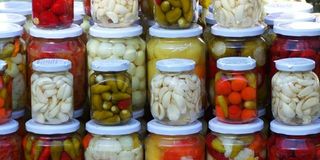Prime
Best ways to preserve food at home

Fermentation keeps food fresh for long. Photo/healthline.com
What you need to know:
- Home food preservation helps you stock up and save money, whether you are growing your own food or buying in bulk.
While fresh foods are a delicacy to many, knowing ways of preserving food may keep it longer for the ‘dry’ days.
Preserving food means using a variety of techniques to keep food from getting spoilt and wasted after harvest or slaughter.
A wide range of preservations are applied to food such as cooking, boiling, refrigeration, freezing, drying, and canning, among others. This basically involves removal or control of factors which affect bacterial growth such as use of low or high temperatures, moisture control, dehydration and use of certain chemicals as preservatives.
According to Franka Piloya, a dietician, there are key aspects and important methods used in maintaining the nutritional value, texture and flavour of all foods as well as controlling and killing microorganisms during food preservation.
They include mostly temperature control methods such as low or high temperatures, which is majorly practised at home, aimed at extending the stability of foods by slowing down or suppressing decay mechanisms through changing relevant factors.
Piloya recommends the following preservation methods:
Refrigeration
This is a temporary food preservation method which involves cooling of foods from zero to five degrees or below, stunting the growth of microorganisms thus preserving food for a certain period of time.
Commonly refrigerated foods are fresh fruits, vegetables, eggs, fish, dairy products, meats.
Freezing
This is the least time consuming and most convenient methods of food preservation because it is very good at retaining the foods’ nutritional value, natural colour and texture than other methods of preservation.
Note: Freezing does not destroy spoilage but stops the growth of microorganisms if maintained below negative 18 degrees.
Food drying
Drying of foods is a dehydration method that involves use of sun and air (wind) to inhibit growth of bacteria, yeast, and mould through removal of moisture content.
Foods that can be dried include fruits, vegetables, legumes, spices, beef and fish. This can be done anywhere as long as the food is properly handled and stored well.
Preservation in salt and sugar
This involves use of salt and sugar as a way of slowing down food spoiling microorganisms by reducing the water content and inhibiting microbial growth.
Common sugar preserved foods are jam for example pineapple, mango, strawberry jam and common salt preserved foods are fish and beef, among others.
Deep fat drying
This involves use of high temperature oils to preserve foods. Common foods preserved using this are tropical foods such as plantain (gonja), Irish potatoes and sweet potatoes made in form of crisps.
Fermentation
This is a chemical reaction in which microorganisms such as bacteria and yeast convert carbohydrates into alcohol.
Common foods include dairy products such as cheese, yoghurt, milk as well as cereals such as millet, sorghum, wheat and maize.
Caution
According to Franka Piloya, a dietician, food preservation starts from how food has been planted, harvested, transported, stored and handled while cooking.
Taking a keen look at any changes such as colour, shapes, texture and moisture content of foods as well as expiry date when buying or shopping, harvesting and storage can prevent any cross contamination by microorganisms for easy preservation.
While using high temperature, ensure that food is not over cooked/boiled or heated and has just enough water to retain its nutrients, texture and flavour. This depends on the time and heat being used in food preservation as well as the destructive effects of heat on the food.
For example, blanching of tomatoes should be done by dipping the tomatoes in boiling water for two to three minutes before the skin is removed, blended and packed.




